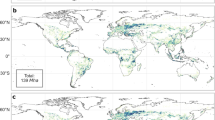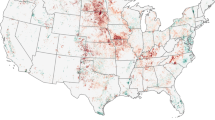Abstract
Do the wet savannahs and shrublands of Africa provide a large reserve of potential croplands to produce food staples or bioenergy with low carbon and biodiversity costs? We find that only small percentages of these lands have meaningful potential to be low-carbon sources of maize (∼2%) or soybeans (9.5–11.5%), meaning that their conversion would release at least one-third less carbon per ton of crop than released on average for the production of those crops on existing croplands. Factoring in land-use change, less than 1% is likely to produce cellulosic ethanol that would meet European standards for greenhouse gas reductions. Biodiversity effects of converting these lands are also likely to be significant as bird and mammal richness is comparable to that of the world’s tropical forest regions. Our findings contrast with influential studies that assume these lands provide a large, low-environmental-cost cropland reserve.
This is a preview of subscription content, access via your institution
Access options
Subscribe to this journal
Receive 12 print issues and online access
$209.00 per year
only $17.42 per issue
Buy this article
- Purchase on Springer Link
- Instant access to full article PDF
Prices may be subject to local taxes which are calculated during checkout




Similar content being viewed by others
References
Alexandratos, N. & Bruinsma, J. World Agriculture Towards 2030/2050: The 2012 Revision (ESA Working paper Rome, FAO, 2012); http://go.nature.com/fM9kF2
Deininger, K. & Byerlee, D. Rising Global Interest in Farmland: Can it Yield Equitable and Sustainable Results? (World Bank, 2011).
Lambin, E. F. & Meyfroidt, P. Global land use change, economic globalization, and the looming land scarcity. Proc. Natl Acad. Sci. USA 108, 3465–3472 (2011).
Hoogwijk, M., Faaij, A., Eickhout, B., de Vries, B. & Turkenburg, W. Potential of biomass energy out to 2100, for four IPCC SRES land-use scenarios. Biomass Bioenergy 29, 225–257 (2005).
van Vuuren, D. P., van Vliet, J. & Stehfest, E. Future bio-energy potential under various natural constraints. Energy Policy 37, 4220–4230 (2009).
Cai, X., Zhang, X. & Wang, D. Land availability for biofuel production. Environ. Sci. Technol. 45, 334–339 (2011).
Chum, H. et al. in IPCC Spec. Rep. Renew. Energy Sources Clim. Change Mitig. (eds Edenhofer, O. et al.) (International Panel on Climate Change, 2011).
Bauen, M. Bioenergy-A Sustainable and Reliable Energy Source. A Review of Status and Prospects (International Energy Agency, 2009); http://go.nature.com/QX3o1m
Morris, M. & Byerlee, D. Awakening Africa’s Sleeping Giant (World Bank and FAO, 2009).
Stevenson, J. R., Villoria, N., Byerlee, D., Kelley, T. & Maredia, M. Green Revolution research saved an estimated 18 to 27 million hectares from being brought into agricultural production. Proc. Natl Acad. Sci. USA 110, 8363–8368 (2013).
Gebara, M. F. & Thuault, A. GHG Mitigation in Brazil’s Land Use Sector (World Resources Institute, 2013).
Lipinsky, B., Hanson, C., Waite, R. & Searchinger, T. Reducing Food Loss and Waste (World Resources Institute, 2013).
Wirsenius, S., Hedenus, F. & Mohlin, K. Greenhouse gas taxes on animal food products: Rationale, tax scheme and climate mitigation effects. Climatic Change 108, 159–184 (2011).
Soares-Filho, B. et al. Cracking Brazil’s forest code. Science 344, 363–364 (2014).
Wilkie, D., Shaw, E., Rotberg, F., Morelli, G. & Auzel, P. Roads, development, and conservation in the Congo Basin. Conserv. Biol. 14, 1614–1622 (2000).
Rosenberger, A., Gingold, B., Prasodjo, R., Alisjahbana, A. & Putraditama, A. How to Change Legal Land Use Classifications to Support More Sustainable Palm Oil Production in Indonesia (World Resources Institute, 2013).
Rulli, M. C., Saviori, A. & D’Odorico, P. Global land and water grabbing. Proc. Natl Acad. Sci. USA 110, 892–897 (2013).
Houghton, R. A. & Hackler, J. L. Carbon Flux to the Atmosphere from Land-Use Changes (TRENDS Compend. Data Glob. Change, 2002); http://www.ornl.gov/w~ebworks/cpr/misc/108689_.pdf
Tilman, D. Global environmental impacts of agricultural expansion: The need for sustainable and efficient practices. Proc. Natl Acad. Sci. USA 96, 5995–6000 (1999).
Foley, J. A. et al. Solutions for a cultivated planet. Nature 478, 337–342 (2011).
Ramankutty, N., Evan, A. T., Monfreda, C. & Foley, J. A. Farming the planet: 1. Geographic distribution of global agricultural lands in the year 2000. Glob. Biogeochem. Cycles 22, 19 (2008).
Palm, C. A., Vosti, S. A., Sanchez, P. A. & Ericksen, P. J. Slash-And-Burn Agriculture: The Search for Alternatives (Columbia Univ. Press, 2013).
West, P. C. et al. Trading carbon for food: Global comparison of carbon stocks vs. crop yields on agricultural land. Proc. Natl Acad. Sci. USA 107, 19645–19648 (2010).
Licker, R. et al. Mind the gap: How do climate and agricultural management explain the ‘yield gap’ of croplands around the world? Glob. Ecol. Biogeogr. 19, 769–782 (2010).
Monfreda, C., Ramankutty, N. & Foley, J. A. Farming the planet: 2. Geographic distribution of crop areas, yields, physiological types, and net primary production in the year 2000. Glob. Biogeochem. Cycles 22, GB1022 (2008).
Haberl, H. et al. Bioenergy: How much can we expect for 2050? Environ. Res. Lett. 8, 031004 (2013).
Thomson, A. M., Izaurralde, R. C., West, T., Parrish, D. J. & Tyler, D. D. Simulating Potential Switchgrass Production in the United States (Pacific Northwest National Laboratory, 2009); http://go.nature.com/j5ey88
Mistry, J. World Savannas: Ecology and Human Use (Prentice Hall, 2000).
Laurance, W. F. et al. Ecosystem decay of Amazonian forest fragments: A 22-year investigation. Conserv. Biol. 16, 605–618 (2002).
Laurance, W. F. et al. The fate of Amazonian forest fragments: A 32-year investigation. Biol. Conserv. 144, 56–67 (2011).
Terborgh, J. et al. Ecological meltdown in predator-free forest fragments. Science 294, 1923–1926 (2001).
Walsh, P. D. et al. Catastrophic ape decline in western equatorial Africa. Nature 422, 611–614 (2003).
Gaston, K. J., Jackson, S. F., Cantú-Salazar, L. & Cruz-Piñón, G. The ecological performance of protected areas. Annu. Rev. Ecol. Evol. Syst. 39, 93–113 (2008).
Rodrigues, A. S. L. et al. Effectiveness of the global protected area network in representing species diversity. Nature 428, 640–643 (2004).
Heckett, T. & Aklilu, N. Agrofuel Development in Ethiopia: Rhetoric, Reality, and Recommendations (Forum for Environment, in partnership with Horn of Africa Regional Environmental Center and Heinrich Boell Stiftung, 2008).
You, L. et al. What is the irrigation potential for Africa? A combined biophysical and socioeconomic approach. Food Policy 36, 770–782 (2011).
Jones, J. W. et al. The DSSAT cropping system model. Eur. J. Agron. 18, 235–265 (2003).
Acknowledgements
The authors wish to thank N. Walker for encouragement and for helping to organize the workshop that gave rise to this paper, and for financial support, the authors wish to thank the Princeton Environmental Institute Development Grand Challenges Program, the David & Lucile Packard Foundation, the Norwegian Agency for Development Cooperation, the Gordon and Betty Moore Foundation, the CGIAR Research Program on Climate Change, Agriculture and Food Security (CCAFS) from the CGIAR Fund and associated donors and the European Union Seventh Framework Programme (FP7/2007–2013) under grant agreement no 308371.
Author information
Authors and Affiliations
Contributions
T.D.S. wrote the paper and contributed to all analyses. L.E. undertook the biodiversity and land-use analyses and contributed to all other analyses. P.K.T. performed the DSSAT crop modelling. T.B. led the bioenergy analysis and all work involving the LPJmL model. A.N. contributed to land-use analysis and mapping. D.R. contributed to the biodiversity analysis. R.H. carried out bioenergy analysis with the GREET model and food and land-use demand needs in SSA. R.L. performed yield gap analysis. M.H. contributed land-use analysis. All authors contributed to the general paper content, thinking and writing.
Corresponding authors
Ethics declarations
Competing interests
The authors declare no competing financial interests.
Supplementary information
Rights and permissions
About this article
Cite this article
Searchinger, T., Estes, L., Thornton, P. et al. High carbon and biodiversity costs from converting Africa’s wet savannahs to cropland. Nature Clim Change 5, 481–486 (2015). https://doi.org/10.1038/nclimate2584
Received:
Accepted:
Published:
Issue Date:
DOI: https://doi.org/10.1038/nclimate2584
This article is cited by
-
Mechanization and sustainable agri-food system transformation in the Global South. A review
Agronomy for Sustainable Development (2023)
-
Implications of zero-deforestation palm oil for tropical grassy and dry forest biodiversity
Nature Ecology & Evolution (2022)
-
The adaptations of the microbial communities of the savanna soil over a period of wildfire, after the first rains, and during the rainy season
Environmental Science and Pollution Research (2022)
-
The soil microbiomes of the Brazilian Cerrado
Journal of Soils and Sediments (2021)
-
Tropical forest loss enhanced by large-scale land acquisitions
Nature Geoscience (2020)



